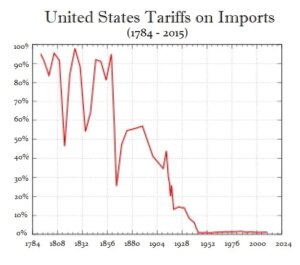Understanding the True Drivers of Economic Turmoil: Unpacking Tariff Myths and the Great Depression
Welcome back to the Extreme Investor Network, where we delve deep into the economic currents shaping our world. Today, we are taking a closer look at a contentious topic in economic history—tariffs—and their often exaggerated role in the Great Depression.
The Current Trade Climate
As we navigate through a complex global economy marked by trade tensions, particularly those involving the U.S. under the Trump administration, it’s crucial to understand the broader implications of tariff policies. Criticism of tariffs is rife, yet the data behind tariffs and trade balances tells a different story, particularly considering the intentions behind them.
Under the current administration, there has been much discussion about how tariffs may influence the domestic economy and international relations. With increased tariffs on several nations, the focus has shifted towards preserving American interests in a landscape often dominated by one-sided free trade agreements. Critics often label tariffs as a tax on consumers; however, such a perspective overlooks their strategic significance in economic nationalism and regional stability.
The Case for Tariffs: A Historical Perspective
Many argue that the tariff policies enacted, particularly the notorious Smoot-Hawley Tariff, have historically been scapegoated for exacerbating economic downturns. Contrary to popular belief, the Smoot-Hawley Tariff, which was intended to protect American farmers by raising duties on agricultural imports, was implemented amidst a plethora of global economic challenges, notably sovereign debt crises across Europe.
In fact, data reveals that tariffs in various forms have been a tool for economic management since the late 18th century, utilized not only for protectionism but also as a response to broader economic disconnects. Understanding their historical context helps demystify their role in economic crises; they often serve as a reactionary measure to existing economic vulnerabilities rather than a direct cause of economic collapse.
The Great Depression: What Really Happened?
Often pinpointed as the primary culprit behind the Great Depression, the Smoot-Hawley Tariff’s timing deserves scrutiny. Passed in June 1930, it came amid a significant stock market decline that had begun long before its enactment. Historical records indicate that the real economic pressures stemmed from numerous sources, including rampant sovereign defaults and structural changes in the labor market, which were compounded by misguided monetary policies.
As we examine the economic landscape of the 1920s, it’s important to recognize the dramatic shifts that were occurring. With over 40% of the labor force employed in agriculture at the turn of the century, the shift towards industrialization was marked by significant productivity gains, notably due to electricity and mechanization. This industrial transformation led to ‘overproduction’, ultimately resulting in a disconnect between supply and consumer demand—far more critical factors than tariffs in triggering economic upheaval.
Debunking the Myths
Many economists point to the Smoot-Hawley Tariff as a turning point that sent the economy spiraling into the abyss. Yet, this narrative neglects the complexity of the economic situation, oversimplifying it to a single legislative act. The interconnected crises, including investment bank defaults, international tensions, and unprecedented global shifts in production practices, culminated in deep-rooted vulnerabilities, leading to the Great Depression.
It is essential to discern between the superficial blaming of tariffs and the underlying structural failures within the global economy. The prevalent narrative often fails to account for systemic issues, including the vulnerability of financial institutions and the burdens inflicted by unsustainable debt levels.
Moving Forward: A Strategic Approach to Tariffs
As we navigate the current landscape, marked by increasing skepticism towards both free trade and protectionist policies, learning from historical precedents becomes imperative. Understanding the complexities of tariffs can provide invaluable insights for crafting a balanced and sustainable trade policy that mitigates risks and fosters economic resilience.
At Extreme Investor Network, we believe that comprehensive analysis and a nuanced understanding of economic factors are crucial for making informed investment decisions and navigating our ever-evolving market landscape. By challenging conventional narratives and analyzing the broader implications of economic policies, we aim to equip you with the tools necessary to face financial uncertainties.
Conclusion
Tariffs, often maligned in popular discourse, exist within a complex interplay of historical and socio-economic factors. Rather than viewing them solely as economic inhibitors, we should recognize their potential as strategic tools to safeguard national interests and stabilize markets. Join us at Extreme Investor Network as we continue to explore and unpack these pressing economic issues, empowering our readers with knowledge and insights that matter.
Stay tuned for future discussions as we delve deeper into the intricate web of economics and its profound impact on investing and market dynamics. Your financial understanding matters—let’s navigate this journey together!

